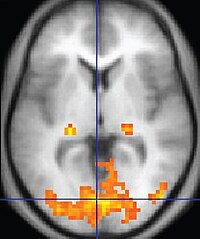
Learning‐related changes in cellular activity within mouse dentate gyrus during trace eyeblink conditioning
Sign Up to like & getrecommendations! Published in 2022 at "Hippocampus"
DOI: 10.1002/hipo.23468
Abstract: Because the dentate gyrus serves as the first site for information processing in the hippocampal trisynaptic circuit, it an important structure for the formation of associative memories. Previous findings in rabbit had recorded populations of… read more here.
Keywords: trace eyeblink; trace; dentate gyrus; eyeblink conditioning ... See more keywords

Caffeine has no effect on eyeblink conditioning in mice
Sign Up to like & getrecommendations! Published in 2018 at "Behavioural Brain Research"
DOI: 10.1016/j.bbr.2017.09.013
Abstract: Abstract Caffeine is one of the most widely used drugs in the world. In the brain, caffeine acts as an antagonist for the adenosine A1 and A2B receptors. Since A1 receptors are highly concentrated in… read more here.
Keywords: caffeine effect; eyeblink conditioning; caffeine; conditioning mice ... See more keywords

Cerebellar transcranial direct current stimulation interacts with BDNF Val66Met in motor learning
Sign Up to like & getrecommendations! Published in 2018 at "Brain Stimulation"
DOI: 10.1016/j.brs.2018.04.009
Abstract: BACKGROUND Cerebellar transcranial direct current stimulation has been reported to enhance motor associative learning and motor adaptation, holding promise for clinical application in patients with movement disorders. However, behavioral benefits from cerebellar tDCS have been… read more here.
Keywords: eyeblink conditioning; tdcs; motor; bdnf val66met ... See more keywords

Filling the gap: Evidence for a spatial differentiation in trace eyeblink conditioning
Sign Up to like & getrecommendations! Published in 2017 at "Neuroscience Letters"
DOI: 10.1016/j.neulet.2017.06.011
Abstract: Trace eyeblink conditioning is used as a translational model of declarative memory but restricted to the temporal domain. Potential spatial aspects have never been experimentally addressed. We employed a spatiotemporal trace eyeblink conditioning paradigm in… read more here.
Keywords: evidence spatial; eyeblink conditioning; trace eyeblink; filling gap ... See more keywords

Social buffering of plasma corticosterone and amygdala responses of young rats following exposure to periorbital shock: Implications for eyeblink conditioning development.
Sign Up to like & getrecommendations! Published in 2021 at "Behavioral neuroscience"
DOI: 10.1037/bne0000462
Abstract: The developmental onset of aversive learning processes depends on complex interactions between endocrine, neural, and social influences. Emergence of avoidance conditioning in rat pups is triggered by elevated plasma corticosterone activating the amygdala. Further, the… read more here.
Keywords: corticosterone; eyeblink conditioning; social buffering; plasma corticosterone ... See more keywords

Weak correlations between cerebellar tests
Sign Up to like & getrecommendations! Published in 2020 at "Scientific Reports"
DOI: 10.1038/s41598-020-65886-1
Abstract: Eyeblink conditioning, finger tapping, and prism adaptation are three tasks that have been linked to the cerebellum. Previous research suggests that these tasks recruit distinct but partially overlapping parts of the cerebellum, as well as… read more here.
Keywords: eyeblink conditioning; tapping prism; conditioning finger; finger tapping ... See more keywords

Trace eyeblink conditioning is associated with changes in synaptophysin immunoreactivity in the cerebellar interpositus nucleus in guinea pigs
Sign Up to like & getrecommendations! Published in 2018 at "Bioscience Reports"
DOI: 10.1042/bsr20170335
Abstract: Synaptic plasticity plays a role during trace eyeblink conditioning (TEBC). Synaptophysin (Syn) is a major integral transmembrane protein, located particularly in the synaptic vesicles, and is considered a molecular marker of synapses. In addition, Syn… read more here.
Keywords: eyeblink conditioning; trace; trace eyeblink; immunoreactivity ... See more keywords

Breathe out and learn: Expiration-contingent stimulus presentation facilitates associative learning in trace eyeblink conditioning.
Sign Up to like & getrecommendations! Published in 2019 at "Psychophysiology"
DOI: 10.1111/psyp.13387
Abstract: Rhythmic variation in heart rate and respiratory pattern are coupled in a way that optimizes the level of oxygen in the blood stream of the lungs and the body as well as saves energy in… read more here.
Keywords: learning trace; expiration; eyeblink conditioning; trace ... See more keywords

-Cardiac cycle and respiration phase affect responses to the conditioned stimulus in young adults trained in trace eyeblink conditioning.
Sign Up to like & getrecommendations! Published in 2022 at "Journal of neurophysiology"
DOI: 10.1152/jn.00298.2021
Abstract: Rhythms of breathing and heartbeat are linked to each other as well as to rhythms of the brain. Our recent studies suggest that presenting the conditioned stimulus during expiration or during the diastolic phase of… read more here.
Keywords: trace eyeblink; conditioned stimulus; eyeblink conditioning; cardiac cycle ... See more keywords

Stimulus Generalization in Mice during Pavlovian Eyeblink Conditioning
Sign Up to like & getrecommendations! Published in 2022 at "eNeuro"
DOI: 10.1523/eneuro.0400-21.2022
Abstract: Abstract Here, we investigate stimulus generalization in a cerebellar learning paradigm, called eyeblink conditioning. Mice were conditioned to close their eyes in response to a 10-kHz tone by repeatedly pairing this tone with an air… read more here.
Keywords: stimulus generalization; tone; eyeblink conditioning; mice ... See more keywords

Young Domestic Pigs (Sus scrofa) Can Perform Pavlovian Eyeblink Conditioning
Sign Up to like & getrecommendations! Published in 2021 at "Frontiers in Behavioral Neuroscience"
DOI: 10.3389/fnbeh.2021.690019
Abstract: Introduction: Pigs have been an increasingly popular preclinical model in nutritional neuroscience, as their anatomy, physiology, and nutrition requirements are highly comparable to those of humans. Eyeblink conditioning is one of the most well-validated behavioral… read more here.
Keywords: conditioning young; eyeblink conditioning; eyeblink; young pigs ... See more keywords